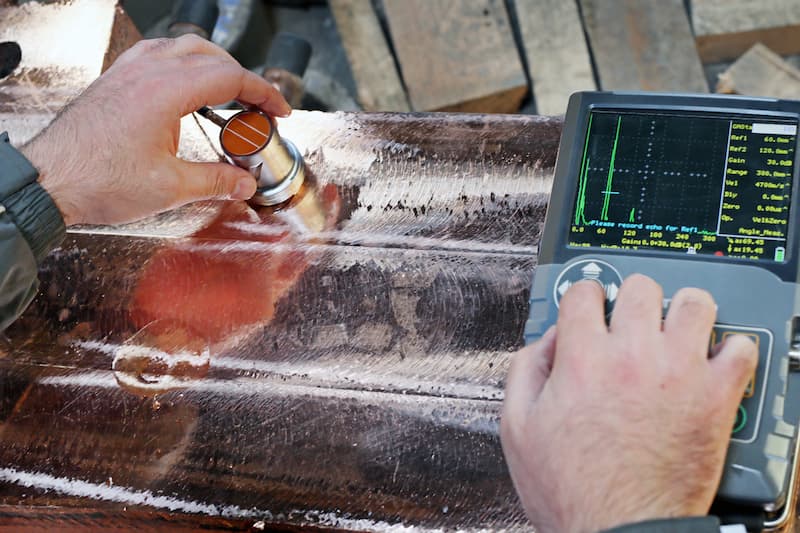Metal fatigue under high-pressure environments is a critical concern within numerous industries, directly influencing the durability and safety of many applications. This intricate process of material weakening due to repeated stress cycles often leads to crack formation and ultimate failure.
As a leading scrap metal recycling and processing business with over 35 years of experience – we aim to unpack the complexities of metal fatigue and its substantial impact in high-pressure situations. In doing so, we hope to provide our customers, and anyone interested in scrap metal an expanded understanding of these critical interactions in our industry.
Understanding Metal Fatigue
Metal fatigue is an engineering term referring to the process whereby a material weakens due to repeated loading and unloading over time. For example, when consistently bending, twisting or being forced in a testing position, metal will be pushed to a limit before snapping. Metals such as steel, iron, copper, and aluminium are commonly susceptible to fatigue, especially when subjected to cyclical stresses over extended periods. These could be fluctuations in temperature, repeated mechanical loading or, as is our focus, high-pressure environments.
High pressure can amplify the effect of these stress cycles. One way to visualise this is by imagining repeatedly inflating and deflating a balloon. Initially, the balloon expands and contracts with each breath. However, the more this continues, the balloon becomes weaker and more likely to break pop at inflation, which was not an issue previously. This is akin to metals under cyclic high pressure – each pressure cycle can cause microscopic cracks that gradually grow and eventually lead to failure.
Each item is placed through a shredder as part of our ferrous and non-ferrous metal recycling process. This machine will push the metal to its limit to break it into shards. It may take several attempts, but eventually, the metal will give, allowing us to process it to the next stage.
Factors Influencing Metal Fatigue in High-Pressure Environments
Pressure and temperature fluctuations can significantly impact metal fatigue. Under high pressure, the stress on a material increase, leading to the initiation and growth of microscopic cracks that eventually culminate in catastrophic failure. Fluctuating temperatures can also contribute to metal fatigue, causing the material to expand and contract. These constant changes can cause additional stress on the material, further complicating the fatigue process.
Loading conditions, too, play a vital role in determining the likeliness of metal fatigue. Stress cycles refer to the range between the minimum and maximum stress exerted on a material during a single loading and unloading cycle. For example, an aircraft’s wing experiences stress cycles during take-off, cruising, and landing, with each phase exerting different stress levels on the wing’s metal components. By understanding these stress cycles, engineers can design materials and structures to withstand the anticipated loading conditions and minimise the risk of metal fatigue.
Which Metals Are More Susceptible?
The molecular structure of metals largely dictates their susceptibility to fatigue. Metals with uniform, ordered molecular structures exhibit higher fatigue resistance than those with disordered or irregular structures. Crystal lattice defects, grain boundaries, and impurities in the metal can all act as stress concentrators, making them more vulnerable to crack initiation.
On the other hand, certain treatments, such as heat treatments and cold working (e.g., rolling and forging), can refine the microstructure and enhance a material’s fatigue resistance. Understanding these correlations between a metal’s molecular structure and fatigue resistance is critical in making well-informed decisions when choosing materials for high-pressure applications. Using the wrong metal construct for specific applications can lead to unsafe structures, which could then require industrial dismantling.
Examples of Industries and Applications Where Metal Fatigue is a Concern
Metal fatigue is a critical issue spanning various industries, particularly those frequently operating under high-pressure environments. Key sectors such as aviation, construction, automotive, and marine are most significantly impacted.
In the aviation industry, metal fatigue can have dire consequences. One historical example is the Aloha Airlines Flight 243 in 1988, where a substantial section of the aircraft’s roof ruptured mid-flight due to decades of metal fatigue.
Construction and automotive industries are other sectors where metal fatigue is of significant concern. Buildings, bridges, and vehicles—made with steel or aluminium—endure various stress cycles, resulting in potential fatigue. For instance, over time, the continuous load and unload cycles experienced by bridges can induce metal fatigue, causing serious structural damage if not monitored.
Similarly, ships and submarines frequently operate under high pressures in the marine industry, making metal fatigue a significant ongoing concern. The recent catastrophic event involving the Titan Submersible offers insight into metal fatigue over time, with reports of the hull potentially having fatigue due to previous visits to the ocean floor. It also helps to understand the importance of using the correct material to withstand pressure. The intense pressure of ocean depths, for instance, induces great stress on submarine hulls, rendering them prone to fatigue over time.
To combat these risks, these sectors invest heavily in thorough and regular inspections and materials testing to detect early signs of fatigue. Metal fatigue understanding can drive the choice of materials, shaping the design and manufacturing processes to ensure the assets’ safety, integrity, and longevity.
Preventing and Mitigating Metal Fatigue
Proper material selection forms the bedrock of fatigue resistance in high-pressure applications. Depending on the anticipated stress cycles, different materials with varied fatigue resistances—ranging from steel and aluminium to titanium alloys—can be chosen to ensure the longevity and safety of the component. The manufacturing process and quality assurance also play a significant role in the fatigue resistance of a component. Processes such as heat treatment or cold working can enhance the microstructure of a metal, thereby improving its fatigue resistance. Further, rigorous quality assurance ensures that only materials meeting the required standards reach the end user, mitigating potential risks associated with defects or impurities.
To detect early signs of fatigue, non-destructive testing methods (such as ultrasonic testing, radiography, or eddy current inspections) can be used. These methods allow for the identification of microscopic cracks or defects which could grow under stress cycles. Maintaining regular checks and proper maintenance is crucial. Routine inspections can allow for early detection and remediation of potential issues, consequently prolonging the metallic assets’ lifespan and precluding catastrophic failures. This blend of material selection, manufacturing, testing, and maintenance helps to manage metal fatigue effectively.
Scrap Your Fatigued Metal
Understanding metal fatigue and its impact on materials operating in high-pressure environments is essential for maintaining various applications’ longevity, safety, and integrity across numerous industries. The risks associated with metal fatigue can be significantly reduced through informed material choices, efficient manufacturing, extensive testing, and proper maintenance.
However, if a project or job has left you with a metal collection no longer usable, ensure you dispose of it in the most environmentally friendly way. At Morecambe Metals, we offer a complete service for scrap metal collection. Whether you can drop off your waste or need to hire a skip for metal, we suit our services to fit your needs. Speak to us today to discuss all your scrap metal needs.







